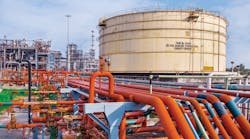By OGJ editors
HOUSTON, Jan. 8 -- Consultants anticipate that there will be more worldwide chlor-alkali capacity built by 2008 than what has currently been announced, and they predict the capacity is apt to be primarily in Northeast Asia and the Middle East.
The Houston-based Chemical Market Associates Inc. (CMAI) recently completed the 2004 World Chlor-Alkali Analysis, which evaluates supply-demand, capacity, chlor-alkali cash costs, and price forecasts through 2008.
Chlor-alkali demand is influenced by economics. When the world gross domestic product dipped in 2001, the gap between installed chlorine capacity and chlorine demand widened, CMAI said.
"As the global economy shows signs of sustained improvement, the gap between nameplate capacity and demand will shrink. The last 3 years of 2% or less GDP growth has not encouraged a sufficient level of reinvestment in chlor-alkali capacity," CMAI said.
CMAI chlor-alkali consultants also said the location of new capacity is changing.
"In a $2/MMbtu natural gas environment in the US, the US Gulf Coast was one of the more economical locations to build new chlor-alkali capacity. In a $5/MMbtu environment, one should no longer expect to see expansions on the US Gulf Coast during the forecast period," consultants said.
If the ratios between crude oil and US natural gas maintain the level experienced in the past 2 years, capacity primarily will be built in Northeast Asia and the Middle East, they said.
"Northeast Asia has competitive production and logistics costs to Southeast Asia, the world's largest caustic importing region. The Middle East has the lowest production costs," they said. Asia is the world's largest vinyls importing region.
